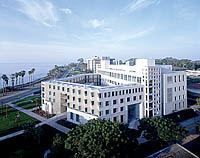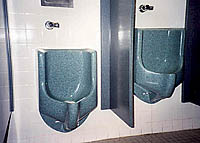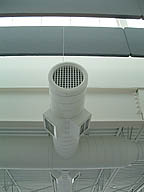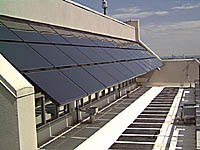

Today we are beginning to see the emergence of a new trend that eventually will change how all buildings are built and maintained. The name of this new concept is the Green Building.
A green building is exactly what you would think it would be - a building that is environmentally correct in every way. One whose design and construction practices significantly reduce or eliminate the negative impact of buildings on the environment and the occupants.
Green building has generally been regarded as a fringe concern, important to only hard-core environmentalists. But with steadily increasing energy prices, many Americans, led by the boomer generation that brought us Earth Day back in 1970, are thinking harder about how to cut energy usage and increase the protection level of the environment.
In the United States, buildings account for
- 36% of total energy use;
- 65% of electricity consumption;
- 30% of greenhouse gas emissions;
- 30% of raw materials use;
- 30% of waste output;
- 12% of potable water consumption.

Americans are also looking twice at green buildings because they have become concerned about indoor air problems linked to toxic chemicals found in some building materials, carpets and furniture.
How does a building become a green building? Through design and construction that concentrates on:
- Conserving water;
- Reducing electricity and energy consumption;
- Reducing the depletion of natural resources;
- Reducing pollution, acid rain, smog and potential of global warming;
- Reducing ozone depletion;
- Improving indoor environmental quality.

The USGBC is a national non-profit organization. It is made up of concerned volunteers who operate on consensus principles. The diverse membership includes architects, engineers, construction contractors, local, state and federal officials, utility representatives, university professors, manufacturers - almost anyone that has anything to do with creating a building and who wants to be involved in protecting the environment.
USGBC's mission is to be the nation's foremost coalition of leaders from across the building industry working to promote buildings that are environmentally responsible, profitable and healthy places to live and work.
USGBC recognized that there needed to be established guidelines so that building owners would have a roadmap by which to make their buildings a green building. Consequently, in 1998, the USGBC established the Leadership in Energy and Environmental Design (LEED) as the official guideline/rating system. This led to a certification process that was established in 2000. The LEED certification/rating system is a national consensus-based, market driven building rating system designed to accelerate the development and implementation of green building practices. In short, it is a leading-edge system for designing, constructing and certifying the world's greenest and best buildings. Under the supervision of the USGBC, the full LEED program offers training workshops, professional accreditation, resource support and third party certification of building performance.

Photo courtesy of hellmuth + bicknese architects (St. Louis, MO)
- Use as a tool for green design guidelines;
- Stimulate green competition;
- Raise consumer awareness;
- Provide definitive standards for what constitutes “green building”;
- A measurement system for rating facilities as “Green”;
- Facilitate positive results for the environment, occupant health and financial return;
- Establish market value with recognizable national “brand”;
- Transform the marketplace.

Photo courtesy of hellmuth + bicknese architects (St. Louis, MO)
Each of the five categories carries a different weight of importance. The categories and their corresponding weight are as follows:
- Energy and Atmosphere --27%;
- Indoor Environmental Quality --23%;
- Sustainable Sites --22%;
- Materials and Resources --20%;
- Water Efficiency --8%.
Plus, you can get extra points through “Innovation and Design.”
Within each category, LEED establishes specific goals by which to measure the owner's intent to qualify for a green building certification.

Why would an owner choose to have a “Green Building”?
- To demonstrate responsible community leadership;
- Gain lower operating cost;
- Provide high-quality working environment;
- Tax incentives;
- Mandate by governing jurisdiction.
As more and more architects and engineers are required to design green buildings, contractors will be forced to quickly learn how to build these buildings. Individual contractors will have to be accredited by LEED in order to meet the building owner's qualification requirements. And, as an upstream supplier to the contractor, we will be required to provide “green” support as well.
The trend is toward more green building investments by more owners. Green building is already part of the way some of our contractors do business, and it will become even more important in years to come. For NIBCO to stay on the leading edge of industry trends, we must recognize the importance of the green movement and be educated in how we can participate in the changes that it will bring. More on green buildings will be forthcoming as we work towards preparing you for the future.

Photo courtesy PowerLight Corporation
LEED: Leadership in Energy and Environmental Design
The LEED (Leadership in Energy and Environmental Design) Green Building Rating System® is a voluntary, consensus-based national standard for developing high-performance, sustainable buildings. Members of the U.S. Green Building Council representing all segments of the building industry developed LEED and continue to contribute to its evolution. LEED standards are currently available or under development for:- New commercial construction and major renovation projects (LEED-NC)
- Existing building operations (LEED-EB)
- Commercial interiors projects (LEED-CI)
- Core and shell projects (LEED-CS)
- Homes (LEED-H)
- Neighborhood Development (LEED-ND)

Photo courtesy General Services Administration
United States GREEN BUILDING COUNCIL'S Green Building Fact Sheet
As of August 2005:
- The annual market for green building in products and services is $7 billion, representing 37% growth over the prior year (based on 2004 figures).
- U.S. Green Building Council (USGBC) Membership includes 5,500 member organizations, including corporations, governmental agencies, and nonprofits. USGBC's membership has grown by 1000% in the past four years.
- 261 million square feet of commercial building space has been registered or certified under LEED. A total of 2,080 registered building projects are currently LEED-NC registered and an additional 254 have completed certification.
- There are LEED projects in all 50 states and 12 countries; 25% are owned by for-profit corporations; 24% are owned by local government; 22% are owned by state & federal government; 19% are owned by nonprofit organizations. Project types of all LEED-registered and certified projects by square footage include: 25% mixed use; 16% commercial office; 8% higher education; 6% K-12.
- 25,615 professionals have been trained through LEED workshops; 20,122 have become LEED Accredited Professionals.
- The Costs and Financial Benefits of Green Buildings: A Report to California's Sustainable Building Task Force, dated October 2003 and based on LEED buildings in the State of California, states that an upfront investment of 2% in green building design, on average, results in life cycle savings of 20% of the total construction costs - more than 10 times the initial investment.
- According to U.S. Environmental Protection Agency (EPA) research, tenants can save about 50 cents per square foot each year through strategies that cut energy use by 30%. This can represent a savings of $50,000 or more in a five-year lease on 20,000 square feet.
